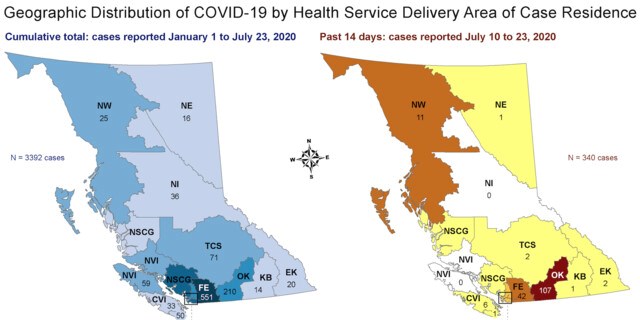By Nicholas Johansen
Data released Thursday by the BC Centre for Disease Control shows what anyone who's been paying attention already knows – the Okanagan has been hit by COVID-19 harder than anywhere else in the province in recent weeks.
From July 10 to 23, 107 residents of the Okanagan were diagnosed with the virus, more than half the cases the region has seen since the pandemic began. The vast majority of these new cases have come in the past week alone.
The spike in cases come after multiple exposure events occurred in Kelowna in late June and early July, stemming from a single group of people who met in Kelowna and attended several private parties. The people had come from Alberta, the Lower Mainland and the Interior, and cases linked to the group have now spread across much of B.C.
Province-wide, 37 per cent of new cases in the past week have been from people between the ages of 20 and 29.
The Okanagan is the only health service delivery area in B.C. that has seen an infection rate greater than 15 cases per 100,000 people over the past 14 days, hitting 28 cases per 100,000 people.
And while the entire IH region had several weeks in a row through June and July with no COVID-19 hospitalizations, two of B.C.'s 16 hospitalizations are now in the Interior.
To date, there have been two virus-related deaths in the IH region, coming in April.
While Dr. Bonnie Henry will only release data by health authority during her regular press conferences, the new numbers show the recent cases in the Interior Health region have all but been entirely contained to the Okanagan.
Over the past two weeks, two of the 112 cases in IH have come from the Thompson-Columbia Shuswap region, two have come from the East Kootenay region, and one has come from the Kootenay-Boundary region. The rest have all been in the Okanagan.
Read more from Castanet



